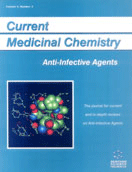Abstract
Chitin is one of the most abundant polysaccharide in the biosphere and consists of unbranched chains of β-(1,4)-linked 2-acetamido-2-deoxy-D-glucose units. In yeast and fungi, chitin serves as mechanical support and useful protective barrier for cell walls. Since chitin is absent from vertebrates, inhibition of its biosynthesis has been considered as a safe and largely selective therapeutic option. Formation of chitin and its deposition is a highly complex and interconnected series of biochemical and biophysical events and the last step of this biosynthesis is governed by an enzymatic activity called chitin synthase or chitin synthetase. The best known and most effective inhibitors of chitin synthase, with marked antifungal activities, are the naturally occurring Polyoxins and Nikkomycins. Extensive efforts have recently been made to look for new naturally occurring CS inhibitors or to modify the basic structure of the existing ones, to improve their inhibitory potencies and their antifungal properties. The putative mechanism postulated for the enzymatic process has also been exploited in the design of a new generation of transition-state- or bisubstrate-analogue inhibitors of CS, providing a rational approach in the search for new antifungal agents.
Keywords: antifungals, enzyme, inhibition, chitin synthase, design, transition-state-analogues
 7
7

